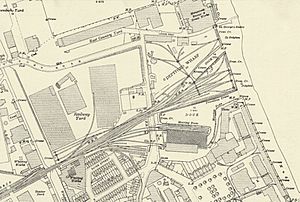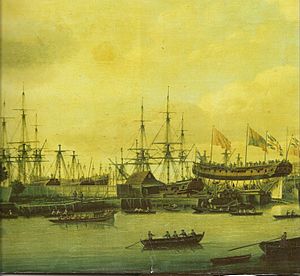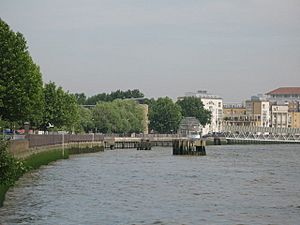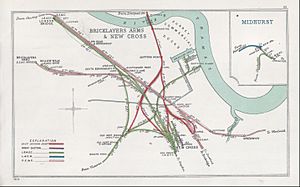Deptford Wharf facts for kids
Deptford Wharf is a historic area in London, United Kingdom. It sits along the Thames Path, a walking route beside the River Thames. You can find it southeast of South Dock Marina. It's also north of Aragon Tower, where a stream called the Earl's Sluice flows into the Thames.
For many years, especially in the late 1700s and early 1800s, Deptford Wharf was a busy place for building ships. There were several slips where new ships were launched into the water. Later, when the railway arrived in 1848, the wharf and its docks became important for bringing in coal and other goods. Today, the area has homes built in 1992. These homes stand where old railway tracks and riverside wharves used to be.
Deptford's Busy Docks and Shipyards
A dock was first built here in 1704 by John Winter. It belonged to the Evelyn family. In 1726, people said it had very deep water. They called it the best private dock on the river.
William Dudman started a shipyard here. To finish some big jobs, he worked with Henry Adams and William Barnard. When William Dudman passed away in 1772, his son John Dudman took over. By 1808, the shipyard was known as Dudman & Son. By 1814, it had five building slips and two large dry docks.
Between 1783 and 1812, Dudman's yard built 23 warships for the navy. They also built two large ships for the East India Company. Around 1825, a company called Gordon & Co. ran the shipyard. Then, in 1838, A. Gordon owned it. Gordon built several small steamships, usually weighing 50 to 100 tons. He sold the business in 1842. The sale included a valuable wharf with 128 feet of river space. It also had a foundry, warehouses, and other buildings needed for shipbuilding.
In March 1846, the London and Croydon Railway announced big plans. They said they would get a large wharf and dock next to the Royal Navy's supply yard in Deptford. Later that year, railway companies merged. This project then became part of the London, Brighton and South Coast Railway (LB&SCR). In 1848, they reported buying 400 feet of river space. They also got a 500-foot wharf where 15 or 16 ships could unload at once.
With a new railway line (see below) and other buildings, Deptford Wharf became a very busy trading dock. Around 1900, a new pier was built into the wet dock. Covered areas were added to protect goods from rain.
The railway connection was removed in the early 1960s. At this time, the use of all the Surrey Docks was decreasing. This was because ships became much larger and goods were moved in big containers. Eventually, the Deptford docks were filled in. The area was then rebuilt, mostly with new homes. You can learn more about this at Surrey Commercial Docks.
By 1807, the wet dock was used for ships carrying people to Australia.
Ships Built at Dudman's Yard
This is a list of some of the ships built at Dudman's yard. It is not a complete list.
| Name | Date Built | Notes |
|---|---|---|
| HMS Carnatic | 1783 | Paid for by the East India Company, given to the Navy |
| HMS Phoebe | 1795 | |
| HMS Sirius | 1797 | |
| HMS Lady Nelson | 1798 | |
| HMS Northumberland | 1798 | |
| HMS Renown | 1798 | |
| HMS Apollo | 1799 | |
| HMS Amaranthe | 1804 | |
| HMS Manly | 1804 | |
| HMS Calypso | 1805 | |
| HMS Sultan | 1807 | |
| HMS Royal Oak | 1809 | |
| HMS Duncan | 1811 | |
| HMS Indus | 1812 | |
| Princess Charlotte | 1812 | A ship for the East India Company |
| Duke of Sussex | 1826 | Another East Indiaman, built by Mr. Gordon |
| Queen Adelaide | 1830 | A ship for the West Indies trade, built by Mr. Gordon |
Deptford's Railway Connections
The idea to own a wharf and build a railway line to it came from the London and Croydon Railway. In March 1846, they announced their plans. They said they had arranged to get a large wharf and dock. This was next to the Queen's supply yard in Deptford. A new law was being discussed to let them build a line from there to New Cross. They called this new line the "Thames Junction Branch." Later that year, railway companies joined together. This project then became part of the London, Brighton and South Coast Railway (LB&SCR).
In 1846, the LB&SCR asked their Chief Engineer, Robert Jacomb-Hood, to build this new railway line. It would go from New Cross to the River Thames at Deptford. He also had to design and manage the building of a new dock system. Jacomb-Hood told his assistant, Frederick Banister, to design and manage the railway line and dock. This work was finished in 1849.
The railway tracks where trains waited and were sorted were separated from the docks by Grove Street. This crossing had very wide gates. They had to cross five railway tracks, making them some of the widest level crossing gates in the country.
A map from 1894/95 shows a railway line going north to the granary at Greenland Dock. A 1913 map shows another line added to the south. This line ran along the middle of Grove Street. It went to the HM Victualling Yard, Deptford and the nearby Foreign Cattle Market. (After a law in 1869, imported live cattle had to be killed at the port. This was to stop cattle diseases from spreading.)
The Grove Street railway link was planned in 1871. But it wasn't built until 1899. The City of London owned it. In 1902, it was called the Grove Street Light Railway. There are photos showing a steam train (LB&SCR D1 class) and wagons going down the middle of this street where people lived.
The number of live cattle imported dropped a lot in 1912. This was due to changes in the law. In 1914, the foreign cattle market was sold. It had 23 acres of land and 360 yards of river wharves. It also had its own railway link.
The dock had two places for coal ships to unload. These ships could carry up to 2500 tons of coal. Coal from Newcastle upon Tyne was regularly unloaded here. It was then moved by train to gas works, like the one at Waddon Marsh. Other goods were moved to and from New Cross Marshalling yard. From there, they were sent all over the country.
Deptford Wharf was visited by a special train tour in 1958. This showed that the docks and railway were still being used. The railway line down Grove Street was still connected. However, the victualling yard closed in June 1961. The railway line serving Deptford docks closed a year or two later. The tracks were removed in 1963.






